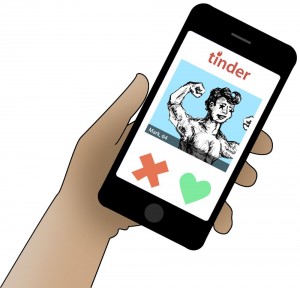Nightlife
To swipe or not to swipe?: The rights and lefts of Tinder on campus
All across campus, thumbs can be seen repeatedly swiping left and right. No, it’s not Flappy Bird or 2048. Tinder’s popularity seems to have exploded in the recent weeks and months, leading to a variety of usage styles amongst Washington University students. Just today, a friend of mine asked me, “So is Tinder where all the other guys are meeting girls?” And the answer I’m leaning toward is yes.
In many ways, the app itself seems shallow. After all, one simply sees a few photos of another person and decides whether or not he is willing to talk to her. So is the simplicity of the app a godsend, or is it disgusting? I would have to argue that it’s both. In fact, we judge each other every minute of every day, often at a very conscious level. Tinder simply avoids the pleasantries and the equivocations. No friend zone. No avoidance. No easy letdowns. Just a right or a left swipe.
Honestly, Tinder has made me more aware of the reason that many college students seem to avoid relationships: the possibility of rejection is very real. By getting on the app, one realizes the reality of the fact that each and every day we are judged based on our appearance and that potential love interests (read that however you will) are deciding whether or not they’re interested in each of us. It’s a harsh reality but one that is worth grasping. After all, each of us is bound to be rejected at some point.
In a strange way, though, Tinder has struck a genius balance: you don’t know when you’re rejected—only when you’re matched. As a result, you get connected with a variety of people who you know have some baseline interest in you. Where you go from there is entirely up to you.
People’s use of the app seems to fall along a spectrum, from those who use it purely as a game to those who seek relationships. Tinder, then, brings into students’ lives anything from uncomfortable texts to sexually explicit photos to long-term, fulfilling relationships.
The way I was first introduced to the app was through its most common use: as a party game of sorts. Students will sit around with their friends in their suites or apartments finding amusement in being matched.
“I mostly just use Tinder as an ego boost, to be honest,” sophomore Kennison Lay said. “I hardly ever talk to people; it’s not something I take particularly seriously as an outlet for meeting people.”
Likewise, sophomore Harrison Kronfeld feels somewhat uncomfortable using the app in any kind of serious way.
“I just find myself scrolling through pictures, but it can feel weird messaging someone you have never met, especially when there is this hookup tone to it,” he said.
However, the reputation of Tinder seems to be on the rise, with students seeing it less as a shameful hookup app and more as way to meet new people.
“Someone had described it as ‘Grindr for straight people,’ so I was under the impression that it was really kind of scuzzy,” junior Emily Keating said. “But I was working on a Spanish project with a few other girls, all three of whom had Tinder, and they assured me that it didn’t have to be purely for torrid hookups.”
The buzz around campus has changed in recent weeks with regard to the app. Personally, I hear less about encounters with arguably crazy people and more about casual dates. It seems that, somewhere in the middle of March, people stopped swiping for ego boosts or asking each other “Coke or Pepsi?” and started asking each other out.
“I got Tinder when my boyfriend and I broke up over the summer because it looked like a fun game I’d seen a lot of my friends playing last school year,” senior Elaine Parmelee said. “It was a nice ego boost coming off of being dumped to have so many new guys chatting me up, but I generally didn’t reply to messages.”
That is until spring break, when anecdotal success stories from her friends gave her the courage to finally respond to a message.
“I never considered meeting up with someone from Tinder because it seemed too risky,” Parmelee said. “But after my friend went on a successful coffee date with one of her matches, I got up the confidence to say yes to two guys in one week…Both dates were kind of scary before they started, but [both] ended successfully.”
It seems the use of Tinder, at least within the Wash. U. community, is beginning to transform into something more serious.
“Tinder can definitely be used for one-night stands, a series of hookups, or even the foundation of a relationship,” Keating said. “It’s just important to establish from the get-go what you’re looking for, particularly if you are looking for more than just a hookup.”
So what are the ground rules? First, I would say to lower your expectations. Second, keep your guard up. But finally, keep an open mind. It’s highly unlikely you’re going to find your soul mate (or even an enjoyable date) on Tinder, but the same goes for any forum for meeting people.
The Wash. U. dating scene is far from ideal. We’re stressed-out college students who may have more comfort with one-night stands than with actually putting ourselves out there. Somehow this app has provided a venue for us to meet people outside the boundaries of everyday life. As the wise sage Ke$ha would perhaps say, “It’s going down; I’m yelling Tinder.”

